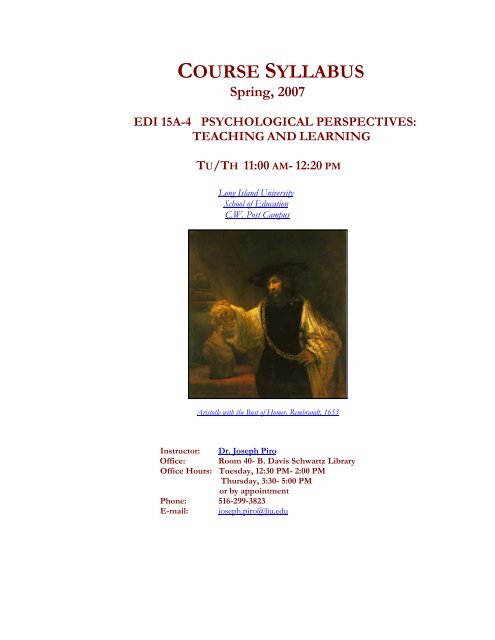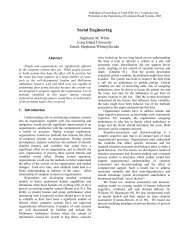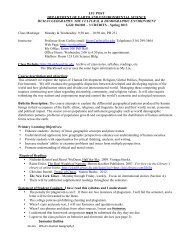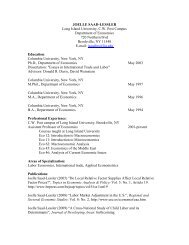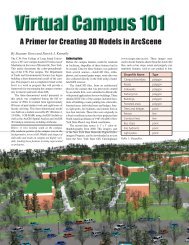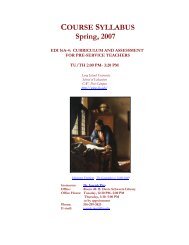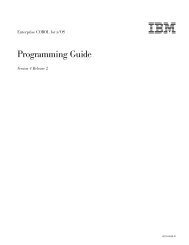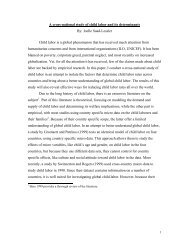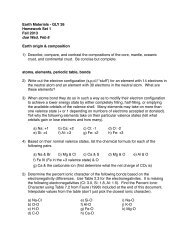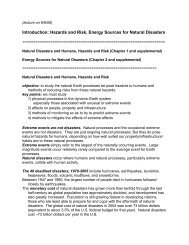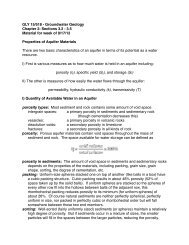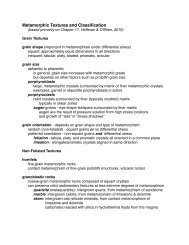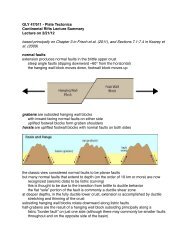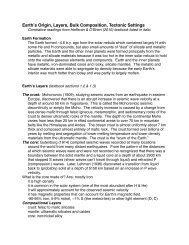COURSE SYLLABUS - Myweb @ CW Post - Long Island University
COURSE SYLLABUS - Myweb @ CW Post - Long Island University
COURSE SYLLABUS - Myweb @ CW Post - Long Island University
You also want an ePaper? Increase the reach of your titles
YUMPU automatically turns print PDFs into web optimized ePapers that Google loves.
REQUIRED <strong>COURSE</strong> TEXT1. Woolfolk, A. Active Learning Edition: Educational Psychology. 2005. Boston: Pearson(ISBN: 0-205-43529-79)The Woolfolk is an Internet-enhanced textbook bundled with resources related to the text. Theseinclude practice tests and a teacher’s casebook as well as a web site and CD-ROM. The CD-ROMincluded in the text catalogues these features. A copy of the textbook is also on reserve in the library.Internet Website for Woolfolk texthttp://www.ablongman.com/catalog/academic/product/0,1144,0205435297,00.html2. Internet Websites throughout the course containing hypertexts of various readings in educationalpsychology.RECOMMENDED <strong>COURSE</strong> TEXTPerrin, Robert. 2004. Pocket Guide to APA Style. Boston: Houghton Mifflin CoSUPPLEMENTAL READINGSArticles and selections from professional books and journals, periodicals, newspapers, andreviews of relevant websites will be discussed throughout the course. Some of these supplementalreadings will be distributed in class. Students will also be expected to keep up with education newsusing Education Week at http://www.edweek.org/<strong>COURSE</strong> APPROACHThis course will combine a variety of techniques and methodologies throughout thesemester and, most importantly, make extensive use of WebCT for online course delivery. Becauseof this, sessions will be conducted both in the assigned classroom and in the Computer Lab in theLibrary. There will be the conventional lecture format and class discussion periods. There will bestudent presentations as well as (possible) guest speakers and a variety of films. Some lectures will beaugmented by PowerPoint presentations.The course will be make extensive use of the Internet with a good portion of the readingassignments able to be accessed online. In addition, students are expected to infuse as muchtechnology-informed strategies possible in both learning the course material and developing theassignments that are part of the course. For each week’s assignments, you will see a variety ofwebsites, some required, some recommended. The fact that most of the readings in the course areweb-based should add to their ease of access and availability. Throughout the course, I welcomeyour input on the effectiveness and usefulness of this approach.Note on E-Mail: The preferred method of communication to me is through e-mail.This includes both WebCT and LIUNET. If you e-mail me through LIUNet using thejoseph.piro@liu.edu address, please make certain your name is in the subject line of the mailso that it may be identified as sent from a student in the class.
<strong>COURSE</strong> WEBSITEThis course will make use of a website uploaded to LIU’s webct-fe address that will containa variety of information related to the course. It is important that you check into the website at leastonce a day to keep up with any news, announcements, messages etc. related to the course. Youshould also check you WebCT e-mail from the course for any other updates I will provide.<strong>COURSE</strong> REQUIREMENTS AND GRADING POLICYStudent involvement in the course will take the following six forms:• Attendance and class participation• Class (oral and written) and Reflection assignments• Response Paper• Exhibition of Learning/ Cooperative Project• Observational Fieldwork and Portfolio• MidtermASSIGNMENT PERCENT DUE DATE(S)1. Attendance, Class Participation& Preparedness10% January 23, 2006May 1, 20072. Reading Matrix 10% May 1, 20073. Response Paper 15% March 22, 20074. Exhibition of Learning 30% Ongoing during course5. Observational Fieldwork 15% May 1, 2007& Reflections6. Midterm examination (late) 20% March 29, 2007Grade Scale Used in Course*95-100 A 77-79 C+90-94 A- 73-76 CCourse grades will be accumulation ofpoints over the semester calculated asfollows:87-89 B+ 70-72 C-83-86 B 65-69 D80-82 B- Below 65 F*NOTE: No INC grades will be given• ATTENDANCE AND CLASS PARTICIPATIONEach class is more than a meeting-- it is an exchange of thoughts and ideas. These types ofexchanges lead to a course with energy and vitality. As prospective teachers you may know there arecertain markers to indicate students are learning. Among these markers, I believe, are engagement indiscussion, the posing of interesting questions, and demonstrating a connection with course content.This course will use similar markers to assess student engagement level. Participation in large andsmall group form discussions is also required. Participation does not just mean talking in class. Its
components include careful listening, meaningful attempts to interpret what is being discussed, activeinvolvement, and critical thinking-- in summary, informed and enthusiastic participation.Excessive absence (generally, three or more class sessions) and lateness, especiallyif unexplained, will result in reduction of grade. Thus, please make every effort to notify theinstructor of any impending absence. All work missed through any absences must be made uppending discussion between student and instructor.Class Participation RubricsOne strategy of effective teaching, you may know, is to inform students of expectation levelsby sharing performance rubrics with them. The performance rubrics for class participation are asfollows:Excellent ContributorGood ContributorFair ContributorNon-ContributorUnsatisfactory ContributorContributions reflect outstanding thought andthorough preparation. Substantive ideas offeredand frequent references made to assignedreadings to support points of view. Offersexciting direction for the class.Contributions reflect meaningful thoughtprocesses and preparation. Usually providessubstantive ideas with occasional referencesmade to assigned readings to support points ofview. Offers good direction for the class.Contributions reflect adequate thought andpreparation. Some references made to assignedreadings but these are generally vague andrandom. Offers adequate direction for the class.Contributions to the class are non-existent.Contributions reflect inadequate preparation.Ideas are not substantive and usually off topic.Offers no direction for the class.• READING MATRIXSpecific required course readings noted with an asterisk will be required to be part of the ongoingReading Matrix for the course. In order to help you make meaning of these readings this matrix willask that you briefly summarize your understandings of the content presented in the readings bycompleting the matrix.• <strong>COURSE</strong> RESPONSE PAPERThis response paper should be 5-6 pages in length (stapled, double-spaced, one-sided,numbered pages, using 1” margins with legible 12 point font, e.g. Times Roman, Garamond)following the 5 th Edition of the APA Publication manual including references and excluding coverpage. Note the length requirement excludes a title page but includes a reference page.
PROJECT ONE: RESPONSE PAPERYour response paper may take two forms:• Option 1: The first is a response to and analysis of a theorist in educationalpsychology as it relates to your own learning experiences. Think of any teacher orclass you’ve taken that has made a particular impression on you. What was it aboutthis experience that has “struck with you?” When you start to reflect on this, beginto tie your thoughts about this together with the theories and theorists thatcomprise this course such as Dewey, Piaget, Vygotsky, Erikson, Skinner, Maslow,and Gardner. How did these teachers “operationalize” the theories we’re nowstudying? Did it make a difference in their teaching? How did it advance thelearning process in their classrooms? You can also focus your paper on yourclassroom observations and talk about what it is you are seeing in action as you visitclassrooms to observe teachers and teaching.This response paper should be designed to critically reflect on issues andideas presented by the theorist(s) you select, especially as to how it has illuminatedhow you view teaching. It should demonstrate how you were able to make meaningout of these theories and how this meaning changed, deepened, or challenged yourown thinking on what constitutes “good” teaching. It should also discuss how youfeel these ideas can be operationalized in the everyday practice of teaching. It shouldalso include a bibliography.• Option 2: The second is an analysis of one research article. We will spend oneclass session learning how to locate and review professional articles using LIU’selectronic data base system available through the C.W. <strong>Post</strong> Library website. Youare to select an article containing a research study from a professional journalrelated to educational psychology and analyze its various components. A list ofsuggested journals can be found on the course website. A good research source isGoogle Scholar. These components include:1. Overall objective and rationale; Research Hypothesis2. Methodology (subjects, research design, procedure)3. Results4. Usefulness to classroom practice5. Meaning for educational psychologyThis critique should communicate the sense that you understood theresearch presented and its purpose and saw a meaningful connection to classroompractice. You should also feel free to comment on the results presented by theauthors and how you feel they square with your own experiences as students andprospective teachers. You could, for example, discuss this article with in-serviceprofessionals you meet during your observations in various school settings and placetheir reactions in the paper along with your own response. This option mustfollow the template that is found on the course web site. Also, please attach acopy of the article to your response paper.Response Papers must be received by the assigned due date Thursday,March 22, 2007. Late submissions will be penalized. Papers must be e-mailed to meusing the Assignment Tool in WebCT or by LIU e-mail up until the due date.Please note that any work e-mailed to me must be formatted in MSWord. Allother formats are incompatible and are unable to be downloaded by me. Papersmay not be faxed.
• EXHIBITION OF LEARNINGThe final Exhibition of Learning (EofL) is a significant part of the course requirement. Itshould synthesize much of what you have learned during the course. It may take one of three forms.• Option 1: Learning ProjectThis option will be a cooperative project completed individually or in class dyads orteams of two students. The project should begin with a specific, course-related questionthat speaks to a topic, issue, concept etc. on teaching and learning that we have discussed(but not exhaustively) during the course. Students should take this idea and develop itusing their own thoughts, impressions, and experiences, viewing it from multipleperspectives. This should include your observational fieldwork. You should also citefrom the literature, e.g., books, professional journals and magazines, and websites, tohelp clarify and broaden your product. For example, you may wish to analyze varioustheories of learning, e.g., Piaget or Vygotsky, and what you feel are their implications forteaching and learning. Or you can talk about how enhancing emotional intelligence canserve to maximize learning and give first-hand accounts of this based upon your ownpersonal and observational experiences. Perhaps you may wish to delve into thepsychology of standardized testing and the impact it is having on the motivational levelsof teachers and students. Whatever your topic, make sure that it intrigues and excitesyou, has some kind of educational psychology perspective and supports your growth andprogress as a teacher. The EofL can take the form of:1. PowerPoint presentation with an accompanying 1-2 page explication of the projectincluding its major points as well as elaboration on information found in thePowerPoint.2. Original Student Website- An example can be found at:http://xruffrydr9.tripod.com/• Option 2: Case StudyThe purpose of this option is to acquaint you with hands-on research practice inpsychology known as the case study. For this option, you should select one student from thepre-K to high school levels for this study and develop an in-depth observational profile basedupon a variety of measures you have pre-constructed that are administered using multipleobservations. You should develop an action plan that will allow you to determine the level offunctioning of the subject in his/her environment(s) using variety of educational (s) psychologymeasures.More information on Case Studies will be available on the course website.Implicit in the definition of an “exhibition of learning” is the forum of a public presentation.All students will present their projects to the class throughout the semester. In effect, you will beteaching the class. These presentations will also be factored into the final grade for the project. Wewill review more details of these presentations during the semester.It is advisable to discuss your (creative) ideas with me before proceeding on project. Youmust submit a working title along with a brief prospectus of the final EofL sometime during thesemester.
• OBSERVATIONAL FIELDWORK & LOGAt least ten hours of observational fieldwork are required for the course together with arecord of your reflections on the experience. These observations may be accomplished in a statecertifiedpublic or non-public school of your choice in a variety of grade levels (from pre-K- 12). Itmay occur in either special (e.g., physical or learning disabilities, inclusion classrooms, gifted) orgeneral education settings-- preferably a combination of both. Please plan this beforehand bydiscussing with your cooperating classroom teacher about your classroom visits: why you are thereand what you hope to accomplish. The cooperating teacher must certify your ten hours ofobservation at the end of the semester. This fieldwork is counted as part of your course grade. If thisfieldwork is not completed during the semester, a final grade will not be issued.Please keep a record of your school visits in which you will record your responses,interactions, and reflections of each experience. In general, talk about what was taught when youobserved, how the material was presented, the engagement level of the students, and your ownreflections and observations about what you remembered most. Try to connect what we discussabout learning theories with authentic classroom practice. This will help guide you in discussions thatwill occur throughout the course. This record will be submitted as part of your course portfolioGuide to Fieldwork Experience at C.W. <strong>Post</strong>: http://myweb.cwpost.liu.edu/mszpara/• MIDTERM EXAMINATIONThe midterm examination will consist of a variety of questions (e.g., multiple choice,constructed responses) that focus on substantive, essential ideas discussed throughout the course.These questions will draw upon classroom texts and discussions, ideas explored in response papers,and observational fieldwork in schools.MISCELLANEOUS <strong>COURSE</strong> ITEMSFilm PresentationsThroughout the course, we will be viewing several films in excerpted as well as full- lengthformat. The films selected all have narratives that relate to some aspect of leaning behavior and helpextend and enrich topics we will be exploring in class. The films (tentatively) scheduled to be showninclude:1. Dead Poets Society2. Prime of Miss Jean Brodie3. The First Year4. The Hobart ShakespeareansINTASC StandardsThe Interstate New Teacher Assessment and Support Consortium (INTASC) is aconsortium of state education agencies and national educational organizations dedicated to thereform of the preparation, licensing, and on-going professional development of teachers. Created in1987, its work is guided by one basic premise: An effective teacher must be able to integrate contentknowledge with the specific strengths and needs of students to assure that all students learn andperform at high levels. INTASC has developed model “core” standards for what all beginning teachersshould know and be able to do in order to practice responsibly, regardless of the subject matter orgrade level being taught. C.W. <strong>Post</strong> encourages its students to become aware of the standards andprepare at least two pieces of “evidence” indicating that they have met each of the 10 CoreStandards. Typically, many of these artifacts are created in courses taken during undergraduatetraining including this one.
Handout FolderI recommend you keep a folder to archive any material distributed in class, e.g. news stories,activity sheets, supplemental items throughout the semester.CLASS POLICIES1. All work submitted for this course must be your own and be written exclusivelyfor this course. The use of sources (ideas, quotations, paraphrases, websites etc.)must be properly documented. Please see me if you have any questions aboutyour use of sources. Also, you may wish to check this website on the <strong>Post</strong>Library web page.2. All assignments are subject to change as announced in class. Please be sure toback up all of your computer files. Please do not turn in your only copy ofassignments.3. Make-Up Assignments- There will be no makeup assignments for unexcusedabsences. To be considered, acceptable excuses (e.g. medical or personalemergencies and/or college related business) must be provided to the instructorin writing. Students who are unable to complete an assignment for legitimatereasons that do not qualify as excused absences and who notify the instructorbefore the assignment is due may, at the discretion of the instructor, turn in lateassignments for partial credit.4. No beepers or cell phones. If you have these items turn them off or tovibrate/quiet mode, so as to not disrupt other students during class.5. Students with disabilities: In accordance with the Americans with DisabilitiesAct of 1990 and in order to facilitate learning for all students, students withdisabilities or those requiring special arrangements should speak directly withthe professor at the beginning of the semester. Further, please contact theAcademic Resource Center (516-299- 2937) so that steps can be taken todevelop an appropriate education plan.6. This course will encourage a high level of professionalism to prepare you forentry into the field of education as a professional. All students are expected toconduct themselves within the bounds of accepted social behavior and submitwork that is appropriate to students planning to enter the teaching professionAlso, you may wish to check this website on the <strong>Post</strong> Library web page.
The criterion of the value of school education is the extent in which it creates a desire forcontinued growth . . . John Dewey, Democracy and EducationWEEK ONEJanuary 23, 25INTRODUCTION AND REVIEW OF <strong>COURSE</strong> <strong>SYLLABUS</strong>,<strong>COURSE</strong> EXPECTATIONS;“WHY DO WE BEHAVE THE WAY WE BEHAVE?”Class session will be held in the Computer LabRequiredWoolfolk, Module 1, pp. 1-17Dewey, John. My Pedagogic Creed*Dewey, J. (1944). Democracy and education. New York: The Free Press. (pp. 41-53, “Education asgrowth,” pp. 81-99 “The democratic conception in education”)Recommended (some of the following pertain to this week’s topics while others span the semester)The Center for Dewey StudiesThe John Dewey SocietyJohn Dewey: Philosophy of EducationAristotle: An OverviewClassic Texts and Manuscripts in EducationA Lexicon of LearningWEEK TWOJANUARY 30, FEBRUARY 1THEORIES OF COGNITIVE DEVELOPMENT:JEAN PIAGETFilm Presentation: The Dead Poets Society (excerpt); The Prime of Miss Jean Brodie (excerpt)REQUIREDWoolfolk, pp. 20-42*Piaget, J. (1952). The origins of intelligence in children. New York: International Universities Press. (pp253- 262 ,“The exploration of new objects and phenomena and the ‘derived’ secondary reactions”)
Piaget, J. (1954). The construction of reality in the child. New York: Basic Books (pp 1-25, “Thedevelopment of object concept”)*Piaget, J. (1962), The stages of the intellectual development of the child. Bulletin of the MenningerClinic, 26, 120- 128.Website of the Jean Piaget SocietyRecommendedCognitive DevelopmentRequiredWoolfolk, pp. 43-59WEEK THREEFEBRUARY 6, 8THEORIES OF COGNITIVE DEVELOPMENT:LEV VYGOTSKY*Vygotsky, L. (1986). Thought and language. Cambridge, MA; The MIT Press. (pp 210- 256, “Thoughtand word”)Abbeduto, L., Ed. (2006). Taking Sides: Clashing views in educational psychology. Should schools adopt aconstructivist approach?, pp.148-177.Bruner, J. “The act of discovery,” pp. 216-227 in Diessner, R., & Simmons, S. Notable selections ineducational psychology. 2000. Guilford, CT: Dushkin/McGraw-HillWebsite of Resources on VygotskyOnline Vygotsky ArchiveBloom’s TaxonomyRecommendedJerome BrunerWEEK FOURFebruary 13, 15
PSYCHOSOCIAL DEVELOPMENT : THE WORK OF ERIK ERIKSONRequiredWoolfolk, pp. 62-77Shakespeare, Seven ages of man*Erikson, E. (1963). Childhood and society- 2nd Edition. New York: W.W. Norton & Co.(pp. 247- 274, “Eight ages of man”)Erikson, E. (1963). Childhood and society- 2nd Edition. New York: W.W. Norton & Co.(pp. 285- 325, “Reflections on the American identity”)RecommendedWebsite for Resources on Erik EriksonWEEK FIVEFebruary 22PSYCHOSOCIAL DEVELOPMENT : THE WORK OF ERIK ERIKSON (CONT’D)*Marcia, J. (2000). “Development and validation of ego-identity status.” pp. 138-48. in Diessner, R.,& Simmons, S. Notable selections educational psychology. Guilford, CT: Dushkin/McGraw-Hill.RequiredWEEK SIXFebruary 27, March 1EXAMINING CLASSROOM MANAGEMENT:CLASSICAL CONDITIONING, BEHAVIORIST PERSPECTIVES AND B.F. SKINNERBelshazzar’s Feast, RembrandtWoolfolk, pp. 187-225*Skinner, B.F. (1953) Shaping and maintaining operant behavior. In Science and human behavior. NewYork: Macmillan.Ivan Pavlov- Website of Nobel Prize LaureatesWebsite of the B.F. Skinner FoundationB.F. Skinner-Biography
RecommendedClassical ConditioningWebsite of Albert BanduraWEEK SEVENMarch 6, 8LEARNER DIFFERENCES: WHAT IS INTELLIGENCE?GARDNER’S MULTIPLE INTELLIGENCES “THEORY”RequiredWoolfolk, pp. 100-115, 136-145*Gardner, H. (1983). Frames of mind. New York: Basic Books (pp. 59- 70, “What is intelligence?”)Gardner, H. (1999). Intelligence reframed: Multiple intelligences for the 21 st Century. New York: Basic Books(pp. 79- 92; “Myths and realities about multiple intelligences”)Abbeduto, L., Ed. (2006). Taking Sides: Clashing views in educational psychology. Can Howard Gardner’stheory of multiple intelligences transform educational practice? pp. 203-230.Walter McKenzie's Multiple Intelligences PagesBloom’s TaxonomyRecommendedMultiple Intelligence after Twenty Years: An Address by Howard GardnerReframing the mindHuman IntelligenceWEEK EIGHTMarch 13, 15INTELLIGENCE (CONT’D); EMOTIONAL INTELLIGENCE
Goleman, D. (1995). Emotional intelligence: Why it can matter more than IQ. New York: Bantam Books(pp. 13- 29, “Anatomy of an emotional hijacking”; pp. 33-45, “When smart is dumb”)Emotional Intelligence: Popular or Scientific PsychologyRecommendedConsortium for Research on Emotional Intelligence for OrganizationsWEEK NINEMarch 20, 22BEGINNING TO TEACHFilm Presentation: The First Year (2001)Woolfolk, pp. 388-421.Marzano, R. (2003). What works in schools: Translating research into action. Alexandria, VA: ASCDPublications (Chapter 10, “Classroom management,” pp. 88-105.)Course Midterm (March 27 th )WEEK TENMarch 27, 29Classroom Roundtable (March 29 th )WEEK ELEVENSPRING RECESSWEEK OF APRIL 2
WEEK TWELVEApril 10, 12CREATING “RESPONSIBLE” LEARNING ENVIRONMENTS:MORAL AND CHARACTER EDUCATION-PIAGET, KOHLBERG, AND GILLIGANDon Giovanni, W.A. Mozart (excerpt)Woolfolk, pp. 78-87*Kohlberg, L. (1984). The psychology of moral development: The nature and validity of moral stages. SanFrancisco: Harper & Row (pp. 7- 24, “Stage and sequence: The cognitive-developmental approach tosocialization,” pp. 170-205, “Moral stages and moralization: the cognitive-developmental approach”)Piaget, J. (1960). The moral judgment of the child. Glencoe, IL: The Free Press. (pp. 195- 219,“Cooperation and the development of the idea of justice”)*Gilligan, C. (1982). In a different voice: Psychological Theory and Women’s Development. Cambridge, MA:Harvard <strong>University</strong> Press. (pp. 1-23, “Introduction” and “Woman’s place in a man’s life cycle”)Studies in Moral Development and Education (click on Overview)Kohlberg’s Theory of Moral DevelopmentWEEK THIRTEENApril 17, 19Film Presentation: L’EnfantMOTIVATION TO LEARN: MASLOW’S HIERARCHIES;CAN PRAISE BE DANGEROUS?RequiredWoolfolk, pp. 338-360; pp. 370-385Abraham MaslowMaslow’s Motivation Theory
*Maslow, A. (1970). Motivation and personality. New York: Harper & Row. (pp. 35-58,“A theory of human motivation”)Dweck, C. (1999).Caution- praise can be dangerous. American Educator, pp. 4-9.Amster, S.E. (1996). The case against rewards and praise: A conversation with Alfie Kohn.Harvard Education Letter, Focus Series No. 2, pp. 4-7.RecommendedAlfie Kohn InterviewLocus of Control InventoryWEEK FOURTEENApril 24, 26CLASSROOM TEACHING: THE THEORIES APPLIEDFilm Presentation: The Hobart ShakespeareansWEEK FIFTEENMay 1STUDENT PRESENTATIONS: FINAL EXHIBITION OF LEARNING
PRIMARY SOURCE REFERENCES FOR EDUCATIONAL PSYCHOLOGYA Selected BibliographyThese books have been placed on reserve in the library.Bruner, J.S. (1960). The process of education. NY: Vintage Books.Bruner, J.S. (1966). Toward a theory of instruction. NY: Norton.Bruner, J.S. (1971). The relevance of education. NY: NortonBruner, J.S. (1973). Beyond the information given: Studies in the psychology of knowing. NY: Norton.Dewey, J. (1910). How we think. Boston: D.C. Heath.Dewey, J. (1916). Democracy and education: An introduction to the philosophy of education. NY: Macmillan.Diesner, R. & Simmons, S. (2000). Notable selections in educational psychology. Guilford, CT:Dushkin/McGraw-Hill.Erikson, E. (1963). Childhood and society (2 nd Ed.). NY: Norton.Erikson, E. (1968). Identity, youth and crisis. NY: Norton.Erikson, E. (1980). Identity and the life cycle (2 nd ed.) NY: Norton.Gardner, H. (1983). Frames of mind: The theory of multiple intelligences. NY: Basic Books.Gardner, H. (1996). Intelligence reframed: Multiple intelligences for the 21 st century. NY: Basic Books.Gilligan, C. (1982). In a different voice: Psychological theory and women’s development. Cambridge, MA:Harvard <strong>University</strong> Press.Goleman, D. (1995). Emotional intelligence: Why it can matter more than IQ. New YorkGoleman, D. (1998). Working with emotional intelligence. New York: Bantam.Kohlberg, L. (1981). The philosophy of moral development. NY: Harper & Row.Kohlberg, L. (1984a). Essays on moral development. San Francisco: Harper & Row.Kohlberg, L. (1984b). The psychology of moral development.: The nature and validity of moral stages. SanFrancisco: Harper & Row.Kohn, A. (1993). Punished by rewards. New York: Houghton-Mifflin.Maslow, A.H. (1968). Toward a psychology of being (2 nd Ed.) NY: Van Nostrand.Maslow, A.H. (1987). Motivation and personality (3 rd Ed.). NY: Harper & Row.
Piaget, J. (1954). The construction of reality in the child. (M. Cook, trans.) New York: Basic Books.Piaget, J. (1963). Origins of intelligence in children. New York: Norton.Piaget, J. (1965). The moral judgment of the child. New York: Free Press.Piaget, J. (1969). The science of education and the psychology of the child. New York: Viking.Piaget, J. (1974). Understanding causality. (D. Miles & M. Miles, trans.) New York: Norton.Skinner, B.F. (1930). The behavior of organisms. NY: Appleton-Century-Crofts.Skinner, B.F. (1953). Science and human behavior. NY: Macmillan.Skinner, B.F. (1974). About behaviorism. NY: Knopf.Skinner, B.F. (1976) Walden two. New York: Prentice-Hall.Sternberg, R.J. (1985). Beyond IQ: A triarchic theory of human intelligence. New York: Cambridge<strong>University</strong> Press.Vygotsky, L.S. (1962). Thought and language (E.H.G. Vakan, trans.). Cambridge, MA: Harvard<strong>University</strong> Press.Vygotsky, L.S. (1978). Mind in society: The development of higher psychological processes. Cambridge, MA:Harvard <strong>University</strong> Press.
INTASC STANDARDSPrinciple #1: The teacher understands the central concepts, tools of inquiry, and structures of thediscipline(s) he or she teaches and can create learning experiences that make these aspects of subjectmatter meaningful for students.Artifact:Artifact:Principle #2: The teacher understands how children learn and develop, and can provide learning opportunitiesthat support their intellectual, social and personal development.Artifact:Artifact:Principle #3: The teacher understands how students differ in their approaches to learning and createsinstructional opportunities that are adapted to diverse learners.Artifact:Artifact:Principle #4: The teacher understands and uses a variety of instructional strategies to encouragestudent’s development of critical thinking, problem solving, and performance skills.Artifact:ArtifactPrinciple #5: The teacher uses an understanding of individual and group motivation and behavior tocreate a learning environment that encourages positive social interaction, active engagement in learning, and selfmotivation.Artifact:ArtifactPrinciple #6: The teacher uses knowledge of effective verbal, nonverbal, and media communicationtechniques to foster active inquiry, collaboration, and supportive interaction in the classroom.Artifact:Artifact:Principle #7: The teacher plans instruction based upon knowledge of subject matter, students, the community, andcurriculum goals.Artifact:Artifact:
Principle #8: The teacher understands and uses formal and informal assessment strategies to evaluate andensure the continuous intellectual, social and physical development of the learner.Artifact:Artifact:Principle #9: The teacher is a reflective practitioner who continually evaluates the effects of his/herchoices and actions on others (students, parents, and other professionals in the learning community)and who actively seeks out opportunities to grow professionally.Artifact:Artifact:Principle #10: The teacher fosters relationships with school colleagues, parents, and agencies in the largercommunity to support students’ learning and well-being.Artifact:Artifact:


